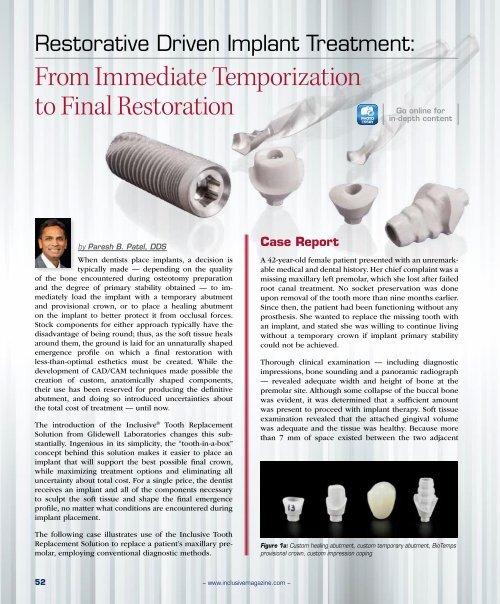PDF Download - Glidewell Dental Labs
PDF Download - Glidewell Dental Labs
PDF Download - Glidewell Dental Labs
Create successful ePaper yourself
Turn your PDF publications into a flip-book with our unique Google optimized e-Paper software.
Restorative Driven Implant Treatment:<br />
From Immediate Temporization<br />
to Final Restoration<br />
Go online for<br />
in-depth content<br />
by Paresh B. Patel, DDS<br />
When dentists place implants, a decision is<br />
typically made — depending on the quality<br />
of the bone encountered during osteotomy preparation<br />
and the degree of primary stability obtained — to immediately<br />
load the implant with a temporary abutment<br />
and provisional crown, or to place a healing abutment<br />
on the implant to better protect it from occlusal forces.<br />
Stock components for either approach typically have the<br />
disadvantage of being round; thus, as the soft tissue heals<br />
around them, the ground is laid for an unnaturally shaped<br />
emergence profile on which a final restoration with<br />
less-than-optimal esthetics must be created. While the<br />
development of CAD/CAM techniques made possible the<br />
creation of custom, anatomically shaped components,<br />
their use has been reserved for producing the definitive<br />
abutment, and doing so introduced uncertainties about<br />
the total cost of treatment — until now.<br />
The introduction of the Inclusive ® Tooth Replacement<br />
Solution from <strong>Glidewell</strong> Laboratories changes this substantially.<br />
Ingenious in its simplicity, the “tooth-in-a-box”<br />
concept behind this solution makes it easier to place an<br />
implant that will support the best possible final crown,<br />
while maximizing treatment options and eliminating all<br />
uncertainty about total cost. For a single price, the dentist<br />
receives an implant and all of the components necessary<br />
to sculpt the soft tissue and shape the final emergence<br />
profile, no matter what conditions are encountered during<br />
implant placement.<br />
The following case illustrates use of the Inclusive Tooth<br />
Replacement Solution to replace a patient’s maxillary premolar,<br />
employing conventional diagnostic methods.<br />
Case Report<br />
A 42-year-old female patient presented with an unremarkable<br />
medical and dental history. Her chief complaint was a<br />
missing maxillary left premolar, which she lost after failed<br />
root canal treatment. No socket preservation was done<br />
upon removal of the tooth more than nine months earlier.<br />
Since then, the patient had been functioning without any<br />
prosthesis. She wanted to replace the missing tooth with<br />
an implant, and stated she was willing to continue living<br />
without a temporary crown if implant primary stability<br />
could not be achieved.<br />
Thorough clinical examination — including diagnostic<br />
impressions, bone sounding and a panoramic radiograph<br />
— revealed adequate width and height of bone at the<br />
premolar site. Although some collapse of the buccal bone<br />
was evident, it was determined that a sufficient amount<br />
was present to proceed with implant therapy. Soft tissue<br />
examination revealed that the attached gingival volume<br />
was adequate and the tissue was healthy. Because more<br />
than 7 mm of space existed between the two adjacent<br />
Figure 1a: Custom healing abutment, custom temporary abutment, BioTemps<br />
provisional crown, custom impression coping<br />
52<br />
– www.inclusivemagazine.com –
















